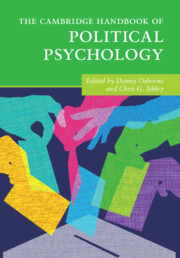Book contents
- The Cambridge Handbook of Political Psychology
- The Cambridge Handbook of Political Psychology
- Copyright page
- Dedication
- Contents
- Figures
- Tables
- Contributors
- Part I Foundations of Political Psychology
- Part II The Politics of Intergroup Attitudes
- Part III Contemporary Challenges to Democracy
- 23 The Political Psychology of Inequality
- 24 How Social Class Influences Political Choices
- 25 Fear and Loathing in American Politics
- 26 Political Extremism
- 27 The Politics of Hate
- 28 Populism
- 29 A Cultural Theory of Autocracy-vs-Democracy
- 30 Psychological Theories Meet the Challenge of Persuading and Mobilising Voters
- 31 Collective Action for Social Change
- 32 Opinion Formation and Polarisation in the News Feed Era
- 33 Conspiracy Theory Belief and Conspiratorial Thinking
- 34 Political Psychology and the Climate Crisis
- 35 The Political Psychology of Cyberterrorism
- 36 Reconciliation in the Aftermath of Collective Violence
- Part IV Diversifying Perspectives in Political Psychology
- Index
- References
32 - Opinion Formation and Polarisation in the News Feed Era
Effects from Digital, Social, and Mobile Media
from Part III - Contemporary Challenges to Democracy
Published online by Cambridge University Press: 17 February 2022
- The Cambridge Handbook of Political Psychology
- The Cambridge Handbook of Political Psychology
- Copyright page
- Dedication
- Contents
- Figures
- Tables
- Contributors
- Part I Foundations of Political Psychology
- Part II The Politics of Intergroup Attitudes
- Part III Contemporary Challenges to Democracy
- 23 The Political Psychology of Inequality
- 24 How Social Class Influences Political Choices
- 25 Fear and Loathing in American Politics
- 26 Political Extremism
- 27 The Politics of Hate
- 28 Populism
- 29 A Cultural Theory of Autocracy-vs-Democracy
- 30 Psychological Theories Meet the Challenge of Persuading and Mobilising Voters
- 31 Collective Action for Social Change
- 32 Opinion Formation and Polarisation in the News Feed Era
- 33 Conspiracy Theory Belief and Conspiratorial Thinking
- 34 Political Psychology and the Climate Crisis
- 35 The Political Psychology of Cyberterrorism
- 36 Reconciliation in the Aftermath of Collective Violence
- Part IV Diversifying Perspectives in Political Psychology
- Index
- References
Summary
Today’s information environment is drastically different from the heyday of print and broadcast, but these changes exceed the scope of researchers’ agendas. More is known now than when these technologies were in their infancy, yet efforts to understand the implications of changing communication technology for media effects have produced mixed findings, limiting progress towards cohesive and generalisable theoretical explanations. A literature review suggests one reason for this is that media effects scholarship has often neglected insights from political psychology and information processing, contributing to a lack of theoretical coherence across these bodies of work. Though research thoroughly examines directional motivations dictating media choice and exposure, it does not equally consider other cognitive biases driving choice, exposure, and processing, which can offset effects from the structural aspects of digital media. Given ample evidence that communication technology influences information processing, any viable, contemporary explanation of media effects must reconcile with these literatures.
- Type
- Chapter
- Information
- The Cambridge Handbook of Political Psychology , pp. 508 - 525Publisher: Cambridge University PressPrint publication year: 2022



